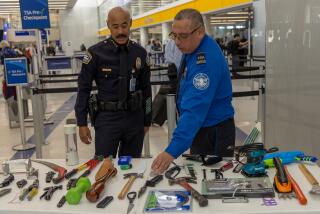Placentia likes the sound of quiet zone designation
It’s been a rough few years in Placentia, an old railroad town that dreamed of carving out trenches for the trains to eliminate the need for engineers to sound their horns as they rolled through town.
After $55 million spent and a near municipal bankruptcy, the trench plans withered and died and two former city leaders were indicted on criminal charges.
Now there’s some good news around the bend.
The city has upgraded its railroad crossings and, next week, Placentia will become one of the first cities in Southern California to be designated a quiet zone, which means engineers won’t have to sound horns.
“I think it will be a blessing for our city,” said Mayor Constance Underhill. “We have been plagued with more trains that blow their horns going through our city that it has become a big quality-of-life issue for our city.”
Barring last-minute hitches, the zone’s first day will be the Fourth of July, prompting Underhill to quip: “Great, we get loud booms in the evening but hopefully no train whistles at night.”
Placentia and Riverside are among six California cities with quiet zones.
The 3 1/2 -mile zone runs from Kellogg Drive on the east to Kraemer Boulevard on the west and touches Anaheim and Yorba Linda.
Trains will go through eight crossings that have been upgraded with additional gates, new sidewalks, synchronized traffic signals and other measures to block cars and pedestrians from entering the right-of-way.
Engineers are required to sound their horns -- three long and two short blasts -- 1,000 feet before reaching a railroad crossing unless a municipality has applied for a quiet zone status and made improvements to intersections, rail officials said.
More than 60 trains daily carry cargo through Placentia from the ports of Los Angeles and Long Beach.
That number is expected to triple by 2020.
The process has taken six years but had the cooperation of Burlington Northern Santa Fe railroad, which owns the corridor, said railroad spokeswoman Lena Kent.
“We have notified our engineers to not blow the whistle beginning on July 4,” Kent said.
Engineers of both freight and passenger trains will still have discretion to sound the horn in case of emergency, said Denise Tyrrell, a Metrolink spokeswoman.
“People who live in the nearby neighborhoods need to understand the level of quiet will depend on the behavior of drivers and pedestrians,” she said.
Pedestrians who walk across the right-of-way and drivers who ignore the gates leave engineers with few options but to blast the train’s horn, she said.
“You can get out of the way, he can’t,” she said.
The city accomplished its mission by shelving the controversial OnTrac trench plan, a $650-million project that drained municipal coffers before its demise about three years ago.
That plan would have rebuilt the Burlington Northern corridor through the heart of Old Town Placentia.
With a trench running for miles, the thinking was that engineers wouldn’t have to sound their horns, traffic wouldn’t pile up at intersections to wait for passing trains, and the bulky boxcars would no longer clutter the city’s historic Old Town district.
But the project derailed several years ago because of a $12-million shortfall in state grants, a stable of high-cost consultants and uncertainty over federal funding.
To keep the project going, officials mortgaged city property, auctioned parkland, cut services and sold $22 million in bonds.
Then two former city officials, OnTrac Executive Director Christopher Becker and City Manager Robert D’Amato, were indicted on felony conflict-of-interest charges in Orange County Superior Court.
They have denied the allegations. Their trial is scheduled for October.
City activist Craig Green, who co-founded Citizens for a Better Placentia, acknowledged the black eye OnTrac has meant for the city.
Under OnTrac, the city spent $18 million for the Melrose Street underpass and to buy private property to make room for the project.
The new zone, by comparison, cost the city $8.5 million, which brings the price for Placentia’s railroad work to more than $70 million, Green said.
“Getting the quiet zone has been an unbelievable blessing,” he said. “It’s something the city fought for, a long, long time.”
More to Read
Start your day right
Sign up for Essential California for news, features and recommendations from the L.A. Times and beyond in your inbox six days a week.
You may occasionally receive promotional content from the Los Angeles Times.






